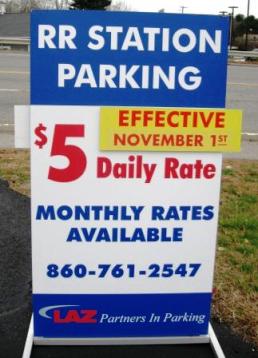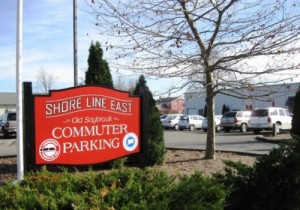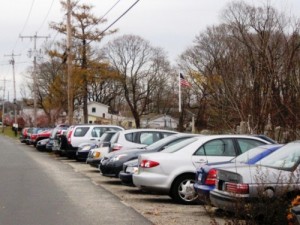 “I think it is lousy,” said a rushing commuter about the new system of having to pay for parking at the Old Saybrook railroad station, which was implemented on Nov. 1.
“I think it is lousy,” said a rushing commuter about the new system of having to pay for parking at the Old Saybrook railroad station, which was implemented on Nov. 1.
She herself was avoiding paying by parking in a free spot well away from the station.
Another rushing morning commuter was Nancy Johnson of Old Saybrook. As for the new fee for parking at the railroad station she said, “I am sad about it. It’s awful. What’s going to happen, when it snows? It’s going to get worse. People are going to get killed.”
“There are no lights in the parking lot,” she added.
Carolann McNeish of Old Saybrook was yet another critic of the new $5 a day parking fee at the station. “We need to encourage people to take the train,” she said. “This discourages them.”
McNeish also said that she had called the town to complain about the new $5 fee to park at the station. However, she was doubtful that it would do any good. As for the separate, free parking lot for Shoreline East commuters, she said despairingly, “It is always full.”
Even the new parking attendant, who has been hired to collect the $5 fees for parking at the station said, “A lot of people are complaining.”
What’s going on here?
Well, it all began when David M. Adams, a partner of Saybrook Realty Partners, decided that it was time to charge for parking on the private property that his firm owns next to the railroad station. This property, called, Saybrook Junction, encompasses both the parking spaces at the shopping plaza, as well as those next to the railroad station.
To put the new “pay for parking” scheme into effect, Adams hired a large professional firm called LAZ Parking, and LAZ in turn hired two parking attendants to collect $5 a day parking fees from frequently puzzled parkers.
One parking attendant is on duty from 5 a.m. to 1 p.m., and the second, works from 1 to 9 p.m. Since there is no on-site booth for the attendants, they simply wander around the parking lot trying to get parkers to pay the $5 fee for parking, when appropriate. When the attendants get cold, they sit in their cars to warm up.
 In addition to putting into place a new “pay-to park” parking scheme, an attempt has also been made to provide free parking for train-bound passengers at two of the station’s “park-free” areas.
In addition to putting into place a new “pay-to park” parking scheme, an attempt has also been made to provide free parking for train-bound passengers at two of the station’s “park-free” areas.
One is an enclosed lot set aside for Shoreline East passengers, which faces North Main Street. On this lot there are 160 free parking spaces. However, the problem is that this Shoreline East lot is frequently full.
Also, there is a parking area reserved for Amtrak passengers. This area has 41 free spaces, and on busy days it too can be full.
 Both of these free parking areas for train riders are well in the back of the Shoreline Junction’s parking spaces, so it is always something of a walk for Shoreline East commuters and Amtrak passengers to reach the station.
Both of these free parking areas for train riders are well in the back of the Shoreline Junction’s parking spaces, so it is always something of a walk for Shoreline East commuters and Amtrak passengers to reach the station.
Furthermore, Shoreline East and Amtrak riders are exempt from paying for parking, only when they are parking in their designated areas. Even if a person has a train ticket in hand, and shows it to the attendant, that is not good enough. They still have to pay for parking.
The parking spaces closest to the new $6 million railroad station building are those which are reserved exclusively for the patrons of the “Pizza Works, Pie and Suds” restaurant. These Pizza Works’ parking spaces generally remain empty throughout the day.
Bob Kehayias of Pizza Works, while intent on preserving his restaurant’s privileged parking spaces, said in a recent interview that the solution to the parking problem at the station should be to build a new, freestanding parking garage, which would provide free parking for all.
Also, Kehayias said that at one time Amtrak owned the parking areas next to the railroad station, but then sold them to the private owner, which he feels was shortsighted. As for the present parking situation at Sayrbook Junction, the pizza restaurant owner says, “Some people are upset and confused.”
Still, some commuters have taken the new parking charges in stride. “It was a nice perk, while it lasted,” said one, referring to the days when parking was free. When Pat Thompson of Essex on her way to the train was asked, if she was angry about having to pay for parking, she replied, “Not a bit.”
To end some of the confusion, here is a summary of our interpretation of when, “To pay, or not to pay,” for parking on Saybrook Junction’s property at the Old Saybrook railroad station.
- Any person who is doing business with one of Saybrook Junction’s tenants, or who is an employee at one of its tenant’s businesses, can park for free.
- Any person parking in the special area reserved for Shoreline East commuter parking can park for free if, of course, they can find a space.
- Any person parking in the designated spaces reserved for Amtrak passengers, which are indicated by painted yellow stripes and located in the back of the parking lot, can park for free, if they can find an empty space.
- Any person parking in the One Hour Parking row can park for free for one hour.
- Any person parking outside the parking lot, such as along North Main Street, can park for free.
- Any handicapped person can park for free in handicapped spaces at the Saybrook Junction parking lot at the station. However, the handicapped parking spaces in the Pizza Works restaurant area require eating at the restaurant at the time of their use.
- Any person that parks in Saybrook Junction’s parking spaces, which do not fit one of the above “park free” categories, must pay $5 a day for parking. Furthermore, if a person, who is required to pay, wants to park for more than one day, they must pay in advance for the multiple days and display their daily receipts, so they can be seen by the attendants.
- As a general rule those persons parking in spaces that are bordered by white stripes are required to pay the $5 a day parking fee.
David Adams, the partner-owner of the Saybrook Junction, said in a recent interview that by instituting charges for parking, “We wanted to get the situation under control and to alleviate the pressure.”
Asked about those people who were parking, but not paying when they should be, he said, ‘’If there is a ten percent slippage, so what.”
Even with the slippage, it appears that charging for parking on Saybrook Junction’s private property at the railroad station is making money. “It’s profitable,” is the way Adams puts it.